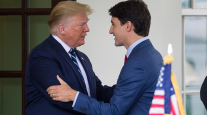Bloomberg News
Canada Climate Plan Calls for 42% Cut in Oil, Gas Emissions

[Stay on top of transportation news: Get TTNews in your inbox.]
Prime Minister Justin Trudeau’s government wants a 42% reduction in emissions from the oil and gas sector as part of Canada’s plan to meet its 2030 emissions reduction goal.
Trudeau’s blueprint promises industry a tax credit to help pay for carbon-capture projects, details of which will be released “soon.” It doesn’t, however, include a specific emissions cap on the fossil-fuel sector, which accounts for about a tenth of Canada’s total economic output.
The document, introduced March 29 in Parliament by Environment Minister Steven Guilbeault, promises an additional C$9.1 billion ($7.3 billion) in new spending to reach Canada’s climate targets. Overall, the government aims to reduce emissions more than 40% below 2005 levels by 2030.

Host Michael Freeze speaks with TMC Chairman Randy Obermeyer and Brenda Neville of the Iowa Motor Truck Association about how to recruit young drivers and technicians. Hear a snippet above, and get the full program by going to RoadSigns.TTNews.com.
In an interview with Bloomberg earlier this month, Guilbeault said existing policies, including phasing out coal-fired electricity generation and adopting a national carbon tax, already have the country on track to reduce emissions by 36%. Getting across the 40% threshold, he said, would require “a lot of heavy lifting.”
It won’t be cheap. The total spending — from both governments and businesses — needed over the next three decades to get Canada to net zero is C$2 trillion, according to a Royal Bank of Canada report last fall, which it said translates to at least C$60 billion a year in spending given current technologies.
The plan says the government is working to reduce oil and gas methane by at least 75% by 2030, and support clean technologies to further decarbonize the sector.
It outlines support for the transition to electric vehicles, including a mandate that at least 20% of all new light-duty vehicles offered for sale by 2026 have zero emissions. The government has previously said it aims to hit 100% in that category by 2035.
The Canada Infrastructure Bank will spend C$500 million on electric vehicle charging infrastructure, and the government will put forward an extra C$400 million toward building charging stations.
Want more news? Listen to today's daily briefing above or go here for more info
Canada’s total greenhouse gas emissions in 2019 were 730 megatons of carbon dioxide equivalent. Oil and gas extraction represents about 26% of those emissions, and the government will be heavily relying on the carbon capture tax credit and the emissions cap to ensure the sector reaches its goals.
On the emissions cap, the government said March 29 a discussion paper will be published this spring, to be followed by consultations with provinces, Indigenous partners, industry and civil society. The government also said it doesn’t plan to use the cap to lower production that is “not driven by declines in global demand.”
Trudeau pledged during last year’s election campaign his Liberals would force oil and gas companies to set five-year targets to cut their emissions with the aim of reaching net-zero emissions by 2050. The program would be poised to begin in 2025. Part of this plan includes a C$2 billion fund to create green jobs in oil-producing regions.
Canada is the only country in the Group of Seven to see its harmful emissions actually rise between 2015 and 2019. Trudeau has blamed his country’s record on emissions to date on the previous Conservative government, which in 2011 withdrew from the Kyoto protocol, a precursor to the 2015 Paris agreement. The prime minister also has said four years of climate skepticism in the U.S. under Donald Trump also effectively held Canada back.
— With assistance from Robert Tuttle.




